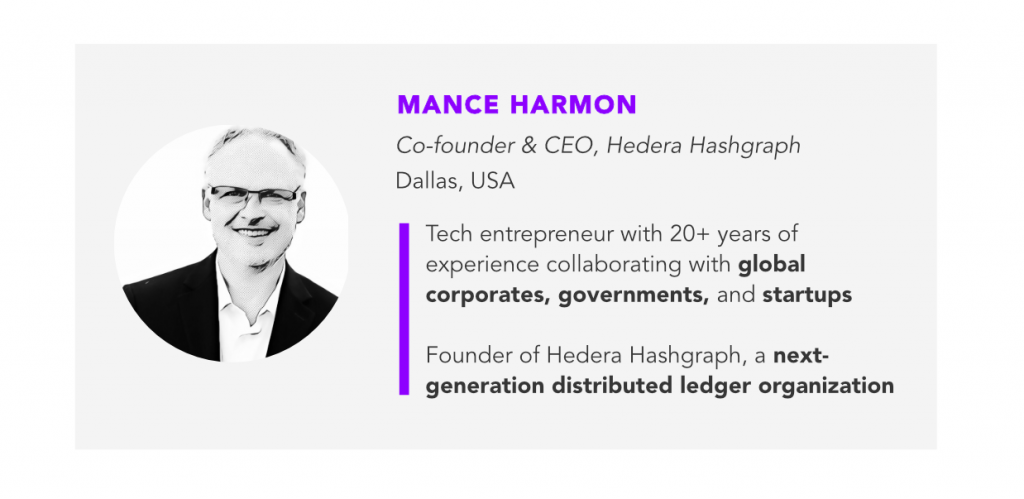The Advantages of Not Being Open Source (Part II)

Key Highlights
- In lieu of being open source, Hedera Hashgraph aims to bring stability to its platform
- Hedera Hashgraph’s cryptocurrency is called HBAR
Listen to the full podcast version of this interview
Transcript of Part II
But Hashgraph in of itself is patented…
Hashgraph is an algorithm, correct. The IP for Hashgraph is privately owned. But it’s … we’re using the patent in order to solve a fundamental problem with existing networks. And the entire community of public distributed ledger technology platforms are all open source, they’re not proprietary, everything is open source. While that’s been good for innovation, it’s also created chaos in a certain way that has prevented mainstream adoption by big enterprise or even medium-sized businesses.
And it’s because everyone knows that these networks like Bitcoin are going to ultimately split into competing networks with competing cryptocurrencies and that represents risk to any business manager considering building an application on one of these public networks. So we’re using the IP of Hashgraph to bring stability to a platform that no other open source platform can achieve.
We’re running the project just like it’s open source in the sense that our source code, the actual code itself, will be published and fully transparent. Anybody that wants to look at it, will be able to do so. And review it and see exactly what we’ve written, every line of code.
But to code with it and to develop products. They have to pay you.
No, no. So the public network doesn’t require a license. So we have transparency, but no license is required to use the network. It’s just like Ethereum. Developers will build applications or DAAPs, distributed applications, that use the services of the network. And when they do so, they pay for those services using the cryptocurrency of the platform at the time that they use the services. It’s micro-payments at the time, the services are used. We’re exactly the same.
So, the developer community can build applications on top of us. And as long as they are paying for the services using the cryptocurrency, like the other platforms do, they don’t even have to tell us who they are. They can do it in total anonymity and they just use platforms.
And the cryptocurrency is called HBAR?
Correct. It’s called HBAR and that’s the major difference. So we’re solving a fundamental problem in that, we’re bringing stability to the DLT market that doesn’t otherwise exist. And also concurrently solving performance and security.
But it does sound very suspiciously like the same as everybody else, except … so if you’re going to conduct yourself like open source and public to a community, why not just make everything open source?
The fact that it’s not open source means that we can prevent the community from leaving and creating a competitive network. And that’s the fundamental problem if you … you’ve got all of these platforms have a governing body.
If it’s the case that the governing body can’t enforce the rules or regulations that they pass. Then that’s weak governance and in fact it’s no governance at all. There are suggestions by the governing body, but if there is a group of the population, that becomes disgruntled then there’s nothing to prevent them from just leaving, forking…
Diluting value…
Absolutely. Creating chaos and preventing the trust in the network needed for mainstream adoption, because of the chaos that would result. So our governing body actually has a tool that makes it possible to bring stability. And that is our IP and the fact that it’s not open source. They can actually pass rules or regulations.
And determine what the product road map is going to be and set rates that are going to be paid to those that participate in the network and fees for the use of the network and all of those things. And they have the authority to enforce them, and so, it’s strong governance in a market that doesn’t have strong governance otherwise.
Keep Watching
Part I: Mance Harmon on Why Hashgraph is a Better Alternative to Blockchain
Part II: The Advantages of Not Being Open Source
Part III: How Hedera Hashgraph Will Spend $100M
Part IV: How the U.S.-China Trade War Impacted Hashgraph
Part V: When Will We See Real-World Solutions?
Part VI: Can Hashgraph Co-Exist With Other Blockchain Players?
Full Interview: In Conversation with Mance Harmon